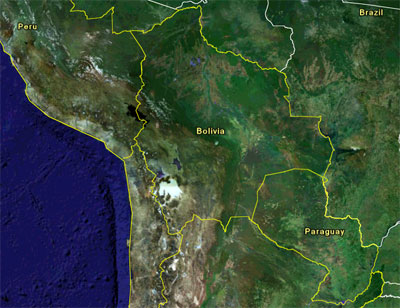BOLIVIA
Please note, this page is not longer being updated. For more recent information, please see news.mongabay.com and use the search function to find the country feed. For more up-to-date data on forest cover and loss, check out Global Forest Watch.
| Bolivia Forest Figures
Forest Cover Total forest area: 58,740,000 ha % of land area: 54.2% Primary forest cover: 29,360,000 ha % of land area: 27.1% % total forest area: 50.0% Deforestation Rates, 2000-2005 Annual change in forest cover: -270,200 ha Annual deforestation rate: -0.5% Change in defor. rate since '90s: 4.4% Total forest loss since 1990: -4,055,000 ha Total forest loss since 1990:-6.5% Primary or "Old-growth" forests Annual loss of primary forests: -135200 ha Annual deforestation rate: -0.5% Change in deforestation rate since '90s: 4.5% Primary forest loss since 1990: -676,000 ha Primary forest loss since 1990:-6.5% Forest Classification Public: n/a Private: n/a Other: n/a Use Production: 0% Protection: 0% Conservation: 20% Social services: 0% Multiple purpose: 80% None or unknown: 0 Forest Area Breakdown Total area: 58,740,000 ha Primary: 29,360,000 ha Modified natural: 29,360,000 ha Semi-natural: n/a Production plantation: 20,000 ha Production plantation: n/a Plantations Plantations, 2005: 20,000 ha % of total forest cover: n.s.% Annual change rate (00-05): n/a Carbon storage Above-ground biomass: 7,828 M t Below-ground biomass: 2,740 M t Area annually affected by Fire: 1,907,000 ha Insects: n/a Diseases: n/a Number of tree species in IUCN red list Number of native tree species: 2,700 Critically endangered: 4 Endangered: 9 Vulnerable: 57 Wood removal 2005 Industrial roundwood: 582,000 m3 o.b. Wood fuel: 38,000 m3 o.b. Value of forest products, 2005 Industrial roundwood: $49,220,000 Wood fuel: $321,000 Non-wood forest products (NWFPs): n/a Total Value: $49,541,000 More forest statistics for Bolivia |
From 1986-1990, the country had a low deforestation rate—about 0.2 percent annually—due to several factors including the Andean-based government's inattention to the lowland parts of the country, the extreme poverty of the country (the government could not afford to offer subsidies to forest developers or construct infrastructure), and the weak export market of this land-locked country. However, during the 1990s, Bolivia's deforestation rate more than doubled to 270,400 hectares per year. The government granted some 20 million hectares to timber companies, while large swaths of forest were cleared for soybean and coca cultivation. Though the government passed laws that required the logging industry to replant forests to ensure sustainability, loopholes made it possible for many firms to bypass the requirement. Further, illegal logging operations smuggled timber into Brazil where it was exported as Brazilian wood.
Today logging continues in Bolivia, though the country has now certified more than two million hectares of its forests, making the it the world leader in tropical forest certification, according to WWF. In 2005 the certified forest sector in Bolivia generated $16 million from exports, a substantial amount given Bolivia's relatively paltry volume of reported wood exports (2,000 metric tons in 2002 according to FAO).
Greater threats to Bolivia's forests come from oil and gas development, commercial agricultural expansion, subsistence agriculture and fuelwood collection, and land-clearing for cattle pasture. In 2005, fires set for land-clearing burned out of control during the record Amazon drought. All told, some 500,000 hectares of forest and pasture land went up in smoke. Agricultural fires are likely to worsen in the future as population pressures mount and the Amazon region experiences drier conditions due to climate change.
It is unclear how the election of Bolivia's first-ever president of Indigenous-descent, Evo Morales, will affect development in rainforest areas. As of February 2006, Morales had not blocked energy projects in the country, nor called for expansion of the country's coca crop.
Bolivia is one of the poorest countries in the Western Hemisphere and is dependent on foreign aid from multilateral lenders and foreign governments. Bolivia's high international debt has presented interesting opportunities for conservation. In 1987 Conservation International initiated the first "debt-for-nature" swap when it purchased $650,000 worth of Bolivian debt for only $100,000. In exchange for being relieved of the obligation to repay a portion of its international debt, the country agreed to set aside funds to promote conservation by encouraging sustainable development, expanding environmental education programs, purchasing land, and improving land management. After the apparent success of the program, in December 1996, the U.S. and Bolivian governments agreed to protect 2.2 million acres (880 000 hectares) of rainforest and to promote sustainable development in and around Noel Kempff Mercado National Park, in part of an international effort to mitigate the emissions of greenhouse gases. In December 2005, the project was expanded to 3.8 million acres (1.5 million hectares).
Including Noel Kempff Mercado National Park, more than 11 percent of Bolivia is officially protected. Bolivia is the twelfth most biodiverse country on Earth with 2,194 known species of amphibians, birds, mammals, and reptiles, and more than 17,000 species of plants. In 2005, Bolivia's biodiversity made science news headlines when Dr. Robert Wallace of the Wildlife Conservation Society discovered a new species of titi monkey in the Madidi protected area. The monkey is now known for its distinctive territorial song.
Recent articles | Bolivia news updates | XML
Suggested reading - Books
- The Rough Guide to Bolivia
- Lonely Planet Bolivia
- Footprint Bolivia
- Culture Shock!: Bolivia
- Tropical Nature: Life and Death in the Rain Forests of Central and South America
- A Neotropical Companion
- Mammals of the Neotropics (Volume 3 ): The Central Neotropics: Ecuador, Peru, Bolivia, Brazil
Unless otherwise specified, this article was written by Rhett A. Butler [Bibliographic citation for this page]
Other resources
Contact me if you have suggestions on other rainforest-related environmental sites and resources for this country.

Image copyright Google Earth, MDA EarthSet, DigitalGlobe 2005
CIA-World Factbook Profile
FAO-Forestry Profile
Last updated: 6 Feb 2006
